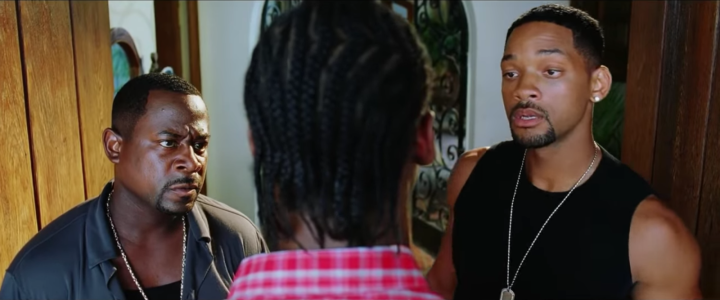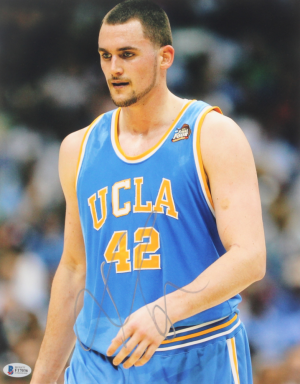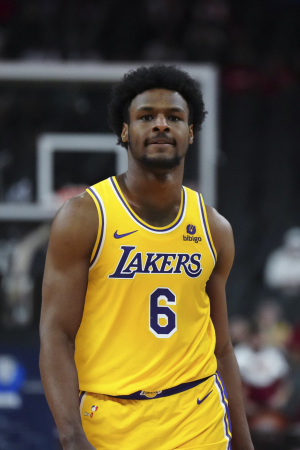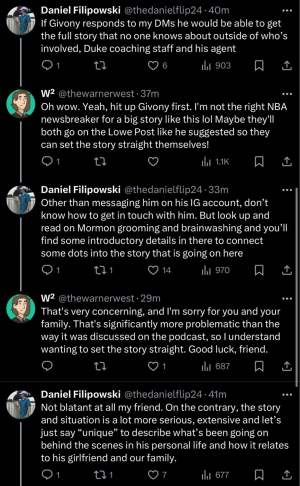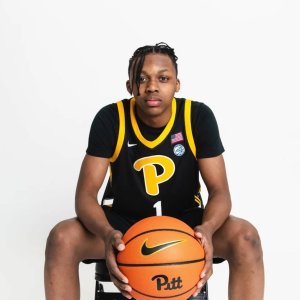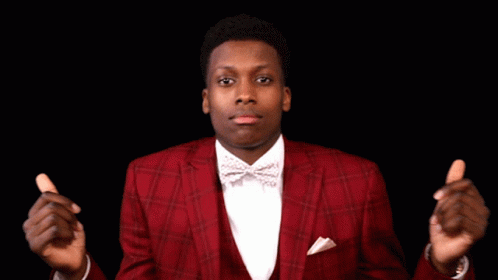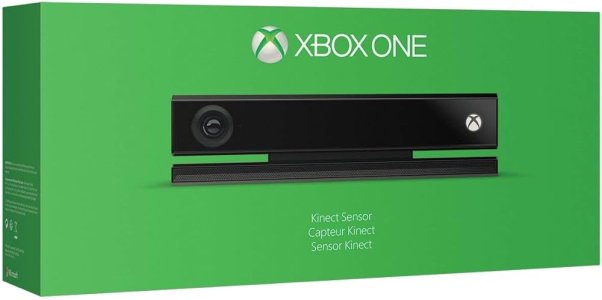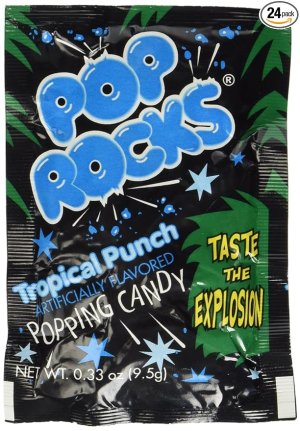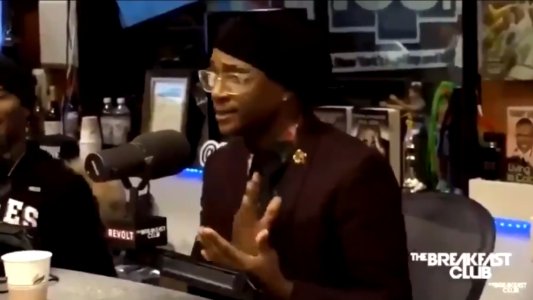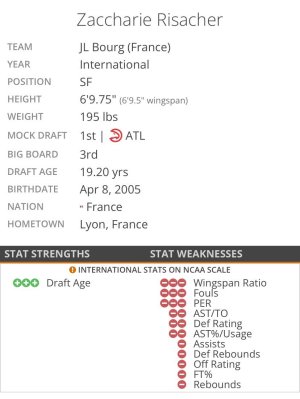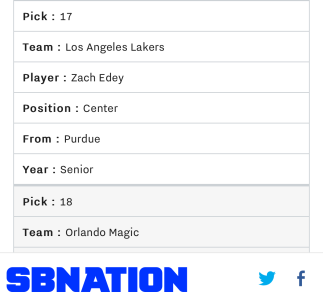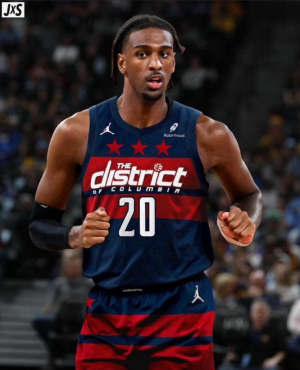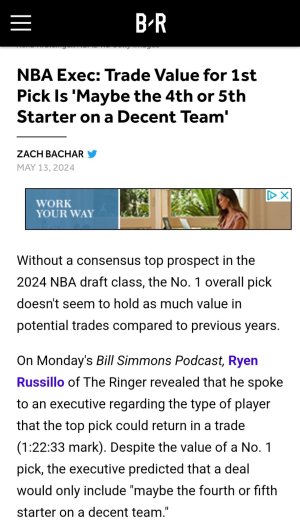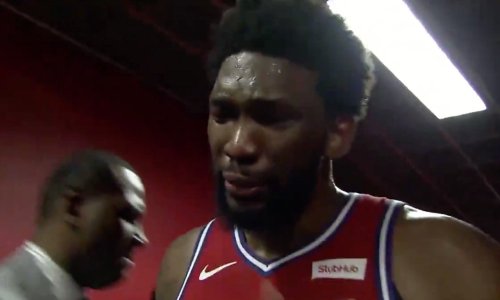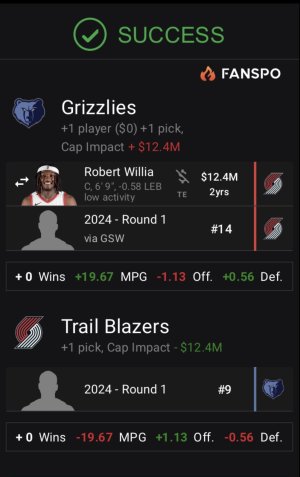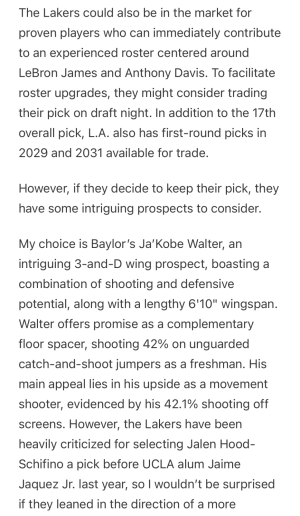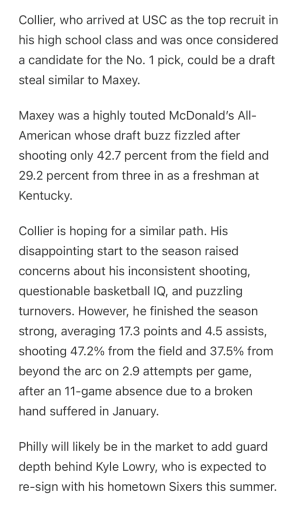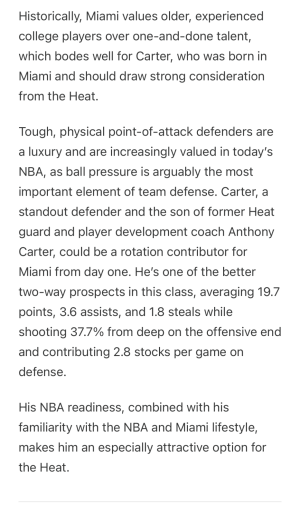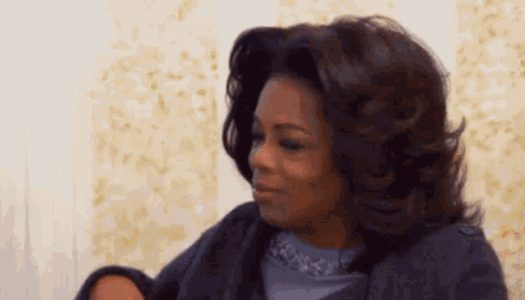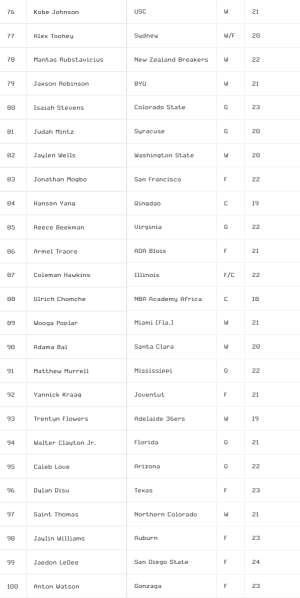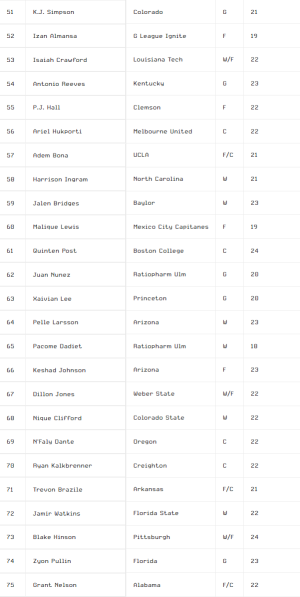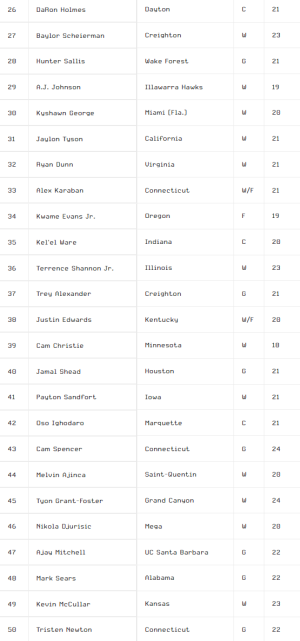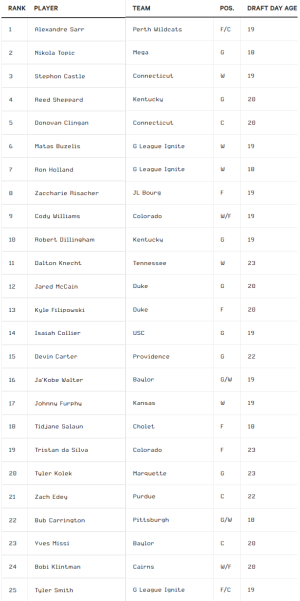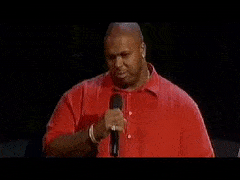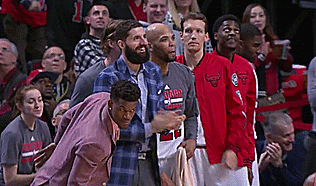- Sep 5, 2010
- 93,328
- 130,107
NBA Draft: How Brandon Miller closed the gap between himself and Scoot Henderson
Over the last few weeks, more high-level NBA decision-makers have gotten a chance to get out into the NBA Draft scouting arenas. And those arenas are more multi-faceted than ever.
College basketball is still where you can see the most prospects. Conference tournaments allow executives to truly prioritize their time well by seeing larger numbers of prospects in the same location in a single day. This year, the SEC tournament was, based on my conversations, the most popular among scouts and executives. Beyond that, the G League Ignite have three potential first-round picks, including potential No. 2 overall pick Scoot Henderson. Overtime Elite just had its playoffs and championship games, where potential lottery picks Amen and Ausar Thompson swept through the event and looked terrific in doing so. And of course, Victor Wembanyama lurks overseas as he leads Metropolitans 92 from the bottom of its league last season toward a top-two regular-season finish this year.
This all leads to more opinions being articulated in conversations with scouts, agents and media members. We’re too early in the process for true smoke screens — those will come once the lottery order is set in May — and with a little more than three months until the draft, teams are really starting to hone in on the tiers in which they have placed prospects on their boards.
These rankings and tiers aren’t set in stone, but they are solidifying. And one opinion starting to solidify for executives in front offices across the NBA is that Alabama forward Brandon Miller is very much in the conversation at No. 2 overall, behind Wembanyama.
This is not a media creation or something with which people are trying to drum up interest at the top of a draft that has had precious little intrigue thus far. It is not a foregone conclusion that Henderson will be picked at No. 2. I’ve talked with a number of lead front-office executives as well as high-level scouts who either think the margin between Miller and Henderson is razor thin or just have Miller ahead at this point.
This is a very stark departure from what has been portrayed throughout the season, when Henderson has been seen at No. 2 on nearly every public-facing big board or mock draft since the preseason up until the last month. Heck, the NBA put on an entire scouting event for Henderson’s Ignite and Wembanyama’s Metropolitans 92 to face off against each other. I still have Henderson at No. 2 on my own mock draft and big board, even following these discussions with teams. He’s an elite-level competitor with elite athleticism, terrific passing and playmaking ability and high-end shot creation upside. I completely buy him. Miller is in the same tier for me, but I’m a believer in Henderson as something like a combination of Anthony Edwards and Derrick Rose.
But the Henderson-Miller conversation has become real over the course of the last few weeks for many who work within NBA front offices. There are a few reasons for that. Largely, it has do with Miller’s play. He’s shown improvement over the course of the season in the exact areas in which scouts wanted to see growth. This isn’t a case where Henderson doesn’t necessarily look like a top pick anymore; it’s that Miller looks like a real option there too. Despite being a year and a half older than Henderson, Miller’s growth trajectory, per these sources, is on a positive plane we’ll talk about below.
All of this, of course, is barring any further fallout from Miller’s situation at Alabama. A police investigator testified in court last month that Miller brought then-teammate Darius Miles the gun that was used in the Jan. 15 fatal shooting of 23-year-old Jamea Jonae Harris. Miller’s attorney rebutted the report, and Miller has remained an active member of the team. Miles and Michael Lynn Davis, who is not associated with the university, have been charged with capital murder.
Prior to the shooting, NBA team sources, who were granted anonymity so that they could speak freely, indicated the cursory early-season background checks they had done into Miller had come back positively. However, this situation has shined a new light onto Miller, and teams will want to do their own due diligence to get all of the information they possibly can.
If nothing changes regarding the current information at NBA teams’ disposal, Miller will be in the mix to be the No. 2 overall pick. Miller, a 6-foot-9 wing, is averaging 19.6 points, 8.3 rebounds and 2.1 assists while shooting 45 percent from the field and 40 percent from 3 on over seven attempts per game. He is considered a solid defender — not a future All-Defense guy like Paul George, but one who could end up as above average in the vein of a Khris Middleton. However, it’s the rate of improvement over this last month that has made scouts extremely excited.
The first question scouts had revolved around Miller’s shot creation off the bounce, particularly going forward toward the rim. Over his first nine games, Miller shot a disastrous 32.8 percent from inside the arc, displaying difficulty getting all the way to the rim because of poor footwork on his drives and an ability to get bumped off balance. Throughout SEC play, Miller nearly doubled that mark, shooting 61.6 percent from 2-point range. In large part, that came from having better plans on his drives. Instead of aimlessly driving and predetermining his move, Miller is now reacting to what defenders present to him and maneuvering around them to get cleaner pathways toward the basket. His last step acceleration has really improved to be able to separate from defenders for that last instant, and he’s done a better job of using his frame to shield defenders from his path with the ball to the basket.
Throughout the process, I’ve been higher on Miller’s ability to string out defenders in ball screens and force those mismatch opportunities against bigs. His handle has never been all that poor; he just hasn’t gotten the most out of that footwork when driving forward toward the rim. Getting to a stepback and being able to drag defenders out is a different skill than attacking the rim. Now that he has worked through the footwork and can play through contact a bit more, everything is coming together in a tangible way for him as an attack-oriented player who can get to the rim. Over his last 12 games, per Synergy, Miller is actually getting to the basket for four shots within 5 feet of the rim per game in the half court (not including transition opportunities). He’s making those at a 58 percent clip, which is good given that he’s self-creating most of them on drives as opposed to finding those shots off cuts.
Off this improved driving patience and skill has come the development of his passing and playmaking. Miller has showcased some high-level, complex reads over the last few weeks that have heartened scouts into believing he can be a player who acts as a secondary initiator of an offense in time. He averaged 3.5 assists over Alabama’s last five games, including a few impressive cross-corner kick-outs and live-dribble looks that showcased impressive vision, as well as the ability to execute high-end reads with one hand. Long seen as something of a point forward at the prep levels, it took a bit of time for Miller to get comfortable with this part of his game at the college level. He’s there now, as you’ll see here.
Essentially, Miller has turned what were perceived to be weaknesses early in the season into strengths. He looks like the kind of prototype bigger wing creator who can defend at a reasonable level who teams covet across the league. Every NBA team I talk to is trying to find guys with plus positional size, athleticism, shooting ability and basketball IQ. Miller ticks some of those boxes more than others, but he doesn’t take anything off of the table in any one of those categories either. This is the player type NBA teams are trying to move heaven and earth to acquire. They’re arguably the hardest type of player to find, and they’re incredibly valuable when they hit.
All of this is why Miller has moved into the conversation at No. 2. This isn’t to say he’ll go higher than Henderson, but it will depend on the team that gets the pick now. It also has helped Miller that Henderson put together arguably his worst month in two years with the Ignite program post-All-Star break. In those eight games, Henderson averaged just 14.9 points while shooting 39 percent from the field and 27 percent from 3. Within that stretch, Henderson also averaged 7.5 assists and upped his rebounding rate substantially. But on the whole, scouts who have seen the Ignite recently have come away just a touch underwhelmed given expectations. And now it looks like Henderson is going to shut things down, as ESPN reported on Tuesday that Henderson will not play in the Ignite’s final five games.
There’s some truth and some fallacy to many of the arguments surrounding Henderson, even from scouts. Some will point to Henderson’s low free-throw rate as evidence that he’s settling too much and might not be an elite driver. I agree Henderson settled far too much recently, but his free-throw rate isn’t great evidence of that. He has only taken about three free-throw attempts per game this season. But in the G League, you only get one free throw attempt on shooting fouls for the first 46 minutes of a game. Only seven players in the entire league who have played in at least 20 games are averaging at least four free throws per game this season. Henderson is 32nd in the league in free throws drawn per game among those 324 players who have seen action in at least 20 games. You’d probably like to see that ranking a bit higher given his explosiveness, but I don’t think it’s a flag.
What is a bit more concerning is that Henderson, an elite athlete with power and physicality to spare in a shredded 6-foot-2 frame featuring a 6-foot-9 wingspan and enormous hands, took 93 shots at the rim in the half court versus 149 midrange jumpers this season. Too often, Henderson seemed comfortable to just get into that midrange area and fire up a 15-footer from the elbows. He’s pretty terrific in the middle of the floor and from the right elbow but hasn’t made a ton from the left side of the floor yet. It’s not all that dissimilar from what we’ve seen from past elite athletes as teenagers. Edwards took just over 100 shots at the rim versus 224 shots from outside of 13 feet in his season at Georgia, per Synergy. Rose took 172 jumpers on 253 half-court shot attempts at Memphis in 2007-08, per Synergy.
You can certainly make the case that Henderson, playing on an NBA-spaced court, should have an easier time getting to the rim. But there are real caveats there. The Ignite are not a team that shoots the ball well. They take the fewest 3s per game in the G League. The team tries to stick Henderson to elite shooting 2012 first-round pick John Jenkins in lineup combinations, but he’s really the only guy providing any space out there. Leonard Miller and Sidy Cissoko are not respected as shooters by opponents. Center Eric Mika has not attempted a 3 this season and is not a particularly vertical rim-runner. London Johnson, Cameron Young and Mojave King, Henderson’s three next-most common lineup partners, all shoot about 32 percent from 3.
To me, it seems like Henderson has things in neutral right now. There are moments when he decides to truly dominate. But more often than not when watching him, it seems like we’re watching an ultra competitor who has nothing to actually compete for. Nobody cares if the G League Ignite wins or loses. Henderson’s been told he’s locked into the No. 2 overall pick in the 2023 draft for over a year. I wouldn’t blame Henderson if he was making a business decision to try to avoid contact to not get hurt — especially given that he’s already suffered a nasal fracture, an ankle injury and a concussion this season. His recent play, where he rarely seems to get into areas with traffic and doesn’t seem all that engaged on the defensive end, would line up with that mindset. I don’t blame him for shutting things down given all of those factors.
Many people around the league are largely willing to give Henderson a relative pass. I haven’t talked to anyone within the NBA who is actually worried about his play. But the race for the No. 2 overall pick is actually competitive, and Miller’s play has really made it a question for NBA teams.
Over the last few weeks, more high-level NBA decision-makers have gotten a chance to get out into the NBA Draft scouting arenas. And those arenas are more multi-faceted than ever.
College basketball is still where you can see the most prospects. Conference tournaments allow executives to truly prioritize their time well by seeing larger numbers of prospects in the same location in a single day. This year, the SEC tournament was, based on my conversations, the most popular among scouts and executives. Beyond that, the G League Ignite have three potential first-round picks, including potential No. 2 overall pick Scoot Henderson. Overtime Elite just had its playoffs and championship games, where potential lottery picks Amen and Ausar Thompson swept through the event and looked terrific in doing so. And of course, Victor Wembanyama lurks overseas as he leads Metropolitans 92 from the bottom of its league last season toward a top-two regular-season finish this year.
This all leads to more opinions being articulated in conversations with scouts, agents and media members. We’re too early in the process for true smoke screens — those will come once the lottery order is set in May — and with a little more than three months until the draft, teams are really starting to hone in on the tiers in which they have placed prospects on their boards.
These rankings and tiers aren’t set in stone, but they are solidifying. And one opinion starting to solidify for executives in front offices across the NBA is that Alabama forward Brandon Miller is very much in the conversation at No. 2 overall, behind Wembanyama.
This is not a media creation or something with which people are trying to drum up interest at the top of a draft that has had precious little intrigue thus far. It is not a foregone conclusion that Henderson will be picked at No. 2. I’ve talked with a number of lead front-office executives as well as high-level scouts who either think the margin between Miller and Henderson is razor thin or just have Miller ahead at this point.
This is a very stark departure from what has been portrayed throughout the season, when Henderson has been seen at No. 2 on nearly every public-facing big board or mock draft since the preseason up until the last month. Heck, the NBA put on an entire scouting event for Henderson’s Ignite and Wembanyama’s Metropolitans 92 to face off against each other. I still have Henderson at No. 2 on my own mock draft and big board, even following these discussions with teams. He’s an elite-level competitor with elite athleticism, terrific passing and playmaking ability and high-end shot creation upside. I completely buy him. Miller is in the same tier for me, but I’m a believer in Henderson as something like a combination of Anthony Edwards and Derrick Rose.
But the Henderson-Miller conversation has become real over the course of the last few weeks for many who work within NBA front offices. There are a few reasons for that. Largely, it has do with Miller’s play. He’s shown improvement over the course of the season in the exact areas in which scouts wanted to see growth. This isn’t a case where Henderson doesn’t necessarily look like a top pick anymore; it’s that Miller looks like a real option there too. Despite being a year and a half older than Henderson, Miller’s growth trajectory, per these sources, is on a positive plane we’ll talk about below.
All of this, of course, is barring any further fallout from Miller’s situation at Alabama. A police investigator testified in court last month that Miller brought then-teammate Darius Miles the gun that was used in the Jan. 15 fatal shooting of 23-year-old Jamea Jonae Harris. Miller’s attorney rebutted the report, and Miller has remained an active member of the team. Miles and Michael Lynn Davis, who is not associated with the university, have been charged with capital murder.
Prior to the shooting, NBA team sources, who were granted anonymity so that they could speak freely, indicated the cursory early-season background checks they had done into Miller had come back positively. However, this situation has shined a new light onto Miller, and teams will want to do their own due diligence to get all of the information they possibly can.
If nothing changes regarding the current information at NBA teams’ disposal, Miller will be in the mix to be the No. 2 overall pick. Miller, a 6-foot-9 wing, is averaging 19.6 points, 8.3 rebounds and 2.1 assists while shooting 45 percent from the field and 40 percent from 3 on over seven attempts per game. He is considered a solid defender — not a future All-Defense guy like Paul George, but one who could end up as above average in the vein of a Khris Middleton. However, it’s the rate of improvement over this last month that has made scouts extremely excited.
The first question scouts had revolved around Miller’s shot creation off the bounce, particularly going forward toward the rim. Over his first nine games, Miller shot a disastrous 32.8 percent from inside the arc, displaying difficulty getting all the way to the rim because of poor footwork on his drives and an ability to get bumped off balance. Throughout SEC play, Miller nearly doubled that mark, shooting 61.6 percent from 2-point range. In large part, that came from having better plans on his drives. Instead of aimlessly driving and predetermining his move, Miller is now reacting to what defenders present to him and maneuvering around them to get cleaner pathways toward the basket. His last step acceleration has really improved to be able to separate from defenders for that last instant, and he’s done a better job of using his frame to shield defenders from his path with the ball to the basket.
Throughout the process, I’ve been higher on Miller’s ability to string out defenders in ball screens and force those mismatch opportunities against bigs. His handle has never been all that poor; he just hasn’t gotten the most out of that footwork when driving forward toward the rim. Getting to a stepback and being able to drag defenders out is a different skill than attacking the rim. Now that he has worked through the footwork and can play through contact a bit more, everything is coming together in a tangible way for him as an attack-oriented player who can get to the rim. Over his last 12 games, per Synergy, Miller is actually getting to the basket for four shots within 5 feet of the rim per game in the half court (not including transition opportunities). He’s making those at a 58 percent clip, which is good given that he’s self-creating most of them on drives as opposed to finding those shots off cuts.
Off this improved driving patience and skill has come the development of his passing and playmaking. Miller has showcased some high-level, complex reads over the last few weeks that have heartened scouts into believing he can be a player who acts as a secondary initiator of an offense in time. He averaged 3.5 assists over Alabama’s last five games, including a few impressive cross-corner kick-outs and live-dribble looks that showcased impressive vision, as well as the ability to execute high-end reads with one hand. Long seen as something of a point forward at the prep levels, it took a bit of time for Miller to get comfortable with this part of his game at the college level. He’s there now, as you’ll see here.
Essentially, Miller has turned what were perceived to be weaknesses early in the season into strengths. He looks like the kind of prototype bigger wing creator who can defend at a reasonable level who teams covet across the league. Every NBA team I talk to is trying to find guys with plus positional size, athleticism, shooting ability and basketball IQ. Miller ticks some of those boxes more than others, but he doesn’t take anything off of the table in any one of those categories either. This is the player type NBA teams are trying to move heaven and earth to acquire. They’re arguably the hardest type of player to find, and they’re incredibly valuable when they hit.
All of this is why Miller has moved into the conversation at No. 2. This isn’t to say he’ll go higher than Henderson, but it will depend on the team that gets the pick now. It also has helped Miller that Henderson put together arguably his worst month in two years with the Ignite program post-All-Star break. In those eight games, Henderson averaged just 14.9 points while shooting 39 percent from the field and 27 percent from 3. Within that stretch, Henderson also averaged 7.5 assists and upped his rebounding rate substantially. But on the whole, scouts who have seen the Ignite recently have come away just a touch underwhelmed given expectations. And now it looks like Henderson is going to shut things down, as ESPN reported on Tuesday that Henderson will not play in the Ignite’s final five games.
There’s some truth and some fallacy to many of the arguments surrounding Henderson, even from scouts. Some will point to Henderson’s low free-throw rate as evidence that he’s settling too much and might not be an elite driver. I agree Henderson settled far too much recently, but his free-throw rate isn’t great evidence of that. He has only taken about three free-throw attempts per game this season. But in the G League, you only get one free throw attempt on shooting fouls for the first 46 minutes of a game. Only seven players in the entire league who have played in at least 20 games are averaging at least four free throws per game this season. Henderson is 32nd in the league in free throws drawn per game among those 324 players who have seen action in at least 20 games. You’d probably like to see that ranking a bit higher given his explosiveness, but I don’t think it’s a flag.
What is a bit more concerning is that Henderson, an elite athlete with power and physicality to spare in a shredded 6-foot-2 frame featuring a 6-foot-9 wingspan and enormous hands, took 93 shots at the rim in the half court versus 149 midrange jumpers this season. Too often, Henderson seemed comfortable to just get into that midrange area and fire up a 15-footer from the elbows. He’s pretty terrific in the middle of the floor and from the right elbow but hasn’t made a ton from the left side of the floor yet. It’s not all that dissimilar from what we’ve seen from past elite athletes as teenagers. Edwards took just over 100 shots at the rim versus 224 shots from outside of 13 feet in his season at Georgia, per Synergy. Rose took 172 jumpers on 253 half-court shot attempts at Memphis in 2007-08, per Synergy.
You can certainly make the case that Henderson, playing on an NBA-spaced court, should have an easier time getting to the rim. But there are real caveats there. The Ignite are not a team that shoots the ball well. They take the fewest 3s per game in the G League. The team tries to stick Henderson to elite shooting 2012 first-round pick John Jenkins in lineup combinations, but he’s really the only guy providing any space out there. Leonard Miller and Sidy Cissoko are not respected as shooters by opponents. Center Eric Mika has not attempted a 3 this season and is not a particularly vertical rim-runner. London Johnson, Cameron Young and Mojave King, Henderson’s three next-most common lineup partners, all shoot about 32 percent from 3.
To me, it seems like Henderson has things in neutral right now. There are moments when he decides to truly dominate. But more often than not when watching him, it seems like we’re watching an ultra competitor who has nothing to actually compete for. Nobody cares if the G League Ignite wins or loses. Henderson’s been told he’s locked into the No. 2 overall pick in the 2023 draft for over a year. I wouldn’t blame Henderson if he was making a business decision to try to avoid contact to not get hurt — especially given that he’s already suffered a nasal fracture, an ankle injury and a concussion this season. His recent play, where he rarely seems to get into areas with traffic and doesn’t seem all that engaged on the defensive end, would line up with that mindset. I don’t blame him for shutting things down given all of those factors.
Many people around the league are largely willing to give Henderson a relative pass. I haven’t talked to anyone within the NBA who is actually worried about his play. But the race for the No. 2 overall pick is actually competitive, and Miller’s play has really made it a question for NBA teams.







